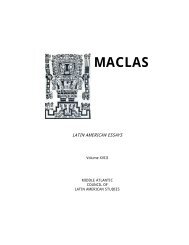latin american essays maclas
latin american essays maclas
latin american essays maclas
You also want an ePaper? Increase the reach of your titles
YUMPU automatically turns print PDFs into web optimized ePapers that Google loves.
presidency and, in coalition with the conservative Party of National Conciliation,<br />
controlled the Assembly (Montgomery 1995; Seligson 2000).<br />
Peace negotiations in Guatemala were even more difficult and lengthy<br />
than in El Salvador. The URNG was much weaker than the FMLN, and thus had<br />
limited bargaining power. The Armed Forces, thought no longer in direct control<br />
of the government after the transition to ostensible democracy in 1985,<br />
continued to have almost complete autonomy and to wield very substantial<br />
political influence. Having the insurgency to battle helped to justify the<br />
continuation of a strong military budget, much of which was in turn channelled<br />
into private enterprises from which top generals profited. Nevertheless, external<br />
pressures (especially from the United States) finally led the dominant faction of<br />
the Armed Forces to support a negotiated peace settlement with the URNG. The<br />
civilian government of Alvaro Arzú (elected early in 1996) then negotiated a<br />
peace settlement with the URNG that was signed at the end of 1996.<br />
Under the accord, the URNG laid down its arms and was accepted as a<br />
legal political party. The Armed Forces were to shrink in responsibility and<br />
budget, and were to be more subject to civilian control. The indigenous<br />
population was to have substantial cultural autonomy. However, implementation<br />
of the accords has been, at best, limited and even pro forma. In practice, the<br />
military proved most unwilling to give up its power, made evident in the<br />
assassination of Bishop Juan Gerardi in 1998, shortly after he released a Human<br />
Rights report sponsored by the Catholic Church. Only low level military<br />
personnel, and a priest, were ever charged in the murder. 5<br />
In 1999, the URNG participated for the first time in a national election,<br />
supporting Alvaro Colom, a centrist candidate for President who ran third (in<br />
2003, without URNG support, Colom made the runoff against centrist Oscar<br />
Berger). The URNG did not compete directly for parliamentary seats in 1999.<br />
Post-Revolutionary Politics 6<br />
Nicaragua. The electoral pattern established in the 1990 Nicaragua<br />
election persisted into the new century, as the FSLN tended to find itself<br />
confronted by relatively unified forces that outweighed the Sandinistas (see<br />
Table 1). The Liberal faction around Arnoldo Alemán had strongly opposed the<br />
pact between Violeta Chamorro and Daniel Ortega, and it was Alemán’s Partido<br />
Liberal Constitucional that prevailed in both 1996 and 2001. The Sandinistas<br />
remained, however, the largest single party, and gained control of municipal<br />
governments throughout the country, including in Managua. Daniel Ortega was<br />
the perennial presidential candidate of the FSLN, and he was not able to pull<br />
enough votes to win against a substantially unified opposition. Through the<br />
decade, then, the Sandinistas remained the principal opposition party (Anderson<br />
and Dodd 2005).<br />
19




